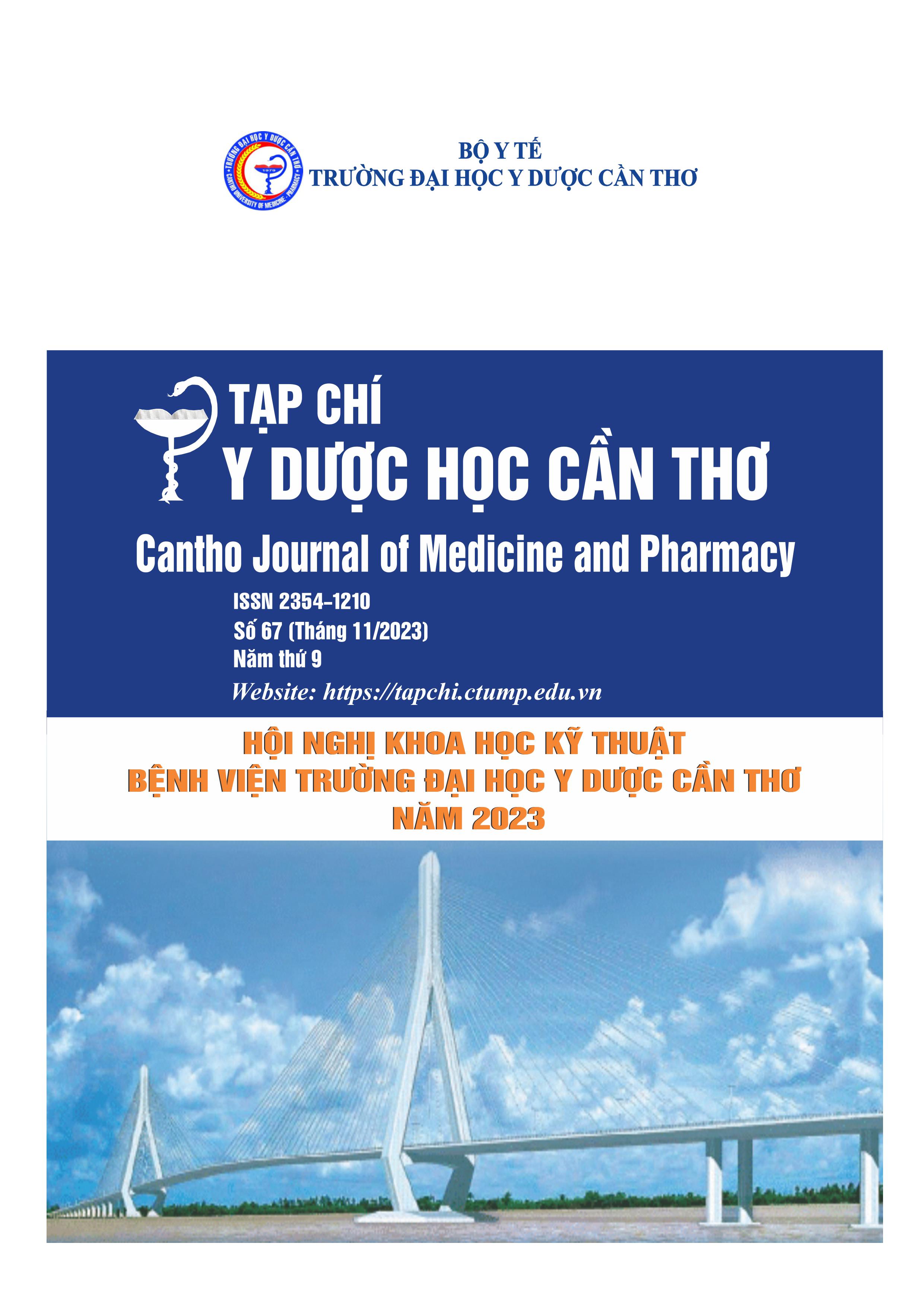STUDY ON THE FREQUENCY AND CHARACTERISTICS OF OBSTRUCTIVE SLEEP APNEA IN PATIENTS WITH TYPE 2 DIABETES
Main Article Content
Abstract
Background: Obstructive sleep apnea (OSA) is common in patients with type 2 diabetes (T2D), with an incidence rate of 85.5%. Therefore, it is essential for diagnosing and identifying characteristics in this patient group. Objectives: 1) To determine the prevalence of obstructive sleep apnea in patients with type 2; 2) To discribe some clinical and subclinical characteristics of obstructive sleep apnea in patients with type. Materials and methods: Randomized study of 32 patients with type 2 diabetes hospitalized at the General Internal Medicine Department of Can Tho University of Medicine and Pharmacy Hospital from April 2023 to September 2023. Results: The mean age of the patients was 68.13 ± 15,13, and the female proportion was 56.2%. The rate of OSA in patients with T2D was 59.4%. The group of T2D patients with OSA had a hypertension proportion of 89.5%, a mean BMI of 24.18 ± 3.95 kg/m2, a mean waist circumference of 92.34 ± 12.46 cm, a daytime sleepiness proportion of 89.5%, a mean HbA1c of 8.96 ± 2.28%, a mean AHI of 25.71 ± 16.41/ hour, a mean ODI of 29.63 ± 18.67/ hour. Conclusions: The rate of OSA in patients with T2D was 59.4%. The group of T2D patients with OSA had hypertension, obesity, common symptoms of daytime sleepiness, and moderate obstructive sleep apnea.
Article Details
Keywords
OSA, T2D, Can Tho University of Medicine and Pharmacy Hospital
References
2. Hoàng Thị Thu Trang, Vũ Văn Giáp. Đặc điểm lâm sàng và cận lâm sàng của hội chứng ngưng thở khi ngủ ở bệnh nhân đái tháo đường type 2. Tạp chí Y học Việt Nam, 2023, 522(2), 27-30. https://doi.org/10.51298/vmj.v522i2.4306
3. Bộ Y tế. Hướng dẫn chẩn đoán và điều trị đái tháo đường típ 2 Ban hành kèm theo Quyết định số 5481/QĐ-BYT ngày 30 tháng 12 năm 2020 của Bộ trưởng Bộ Y tế. Bộ Y tế, Hà Nội. 2020.
4. Urbanik D., Martynowicz H., Mazur G., Poręba R., Gać P. Environmental Factors as Modulators of the Relationship between Obstructive Sleep Apnea and Lesions in the Circulatory System. Journal of Clinical Medicine, 2020, 9(3), 836. https://doi.org/10.3390/jcm9030836.
5. Nguyễn Văn Thành và cộng sự. Thực hành nội khoa bệnh phổi. Nhà xuất bản Y học, Hà Nội. 2022, 154.
6. Tufik S., Santos-Silva R., Taddei J.A., Bittencourt L.R. Obstructive sleep apnea syndrome in the Sao Paulo Epidemiologic Sleep Study. Sleep medicine, 2010, 11(5), 441-446. https://doi.org/10.1016/j.sleep.2009.10.005.
7. Worsnop C.J., Naughton M.T., Barter C.E., Morgan T.O., Anderson A.I. et al. The prevalence of obstructive sleep apnea in hypertensives. American journal of respiratory and critical care medicine, 1998, 157(1), 111-115, https://doi.org/10.1164/ajrccm.157.1.9609063.
8. Cai A., Wang L., Zhou Y. Hypertension and obstructive sleep apnea. Hypertension Research, 2016, 39(6), 391–395. https://doi.org/10.1038/hr.2016.11.
9. Jang Y.S., Nerobkova N., Hurh K., Park E.C., Shin J. Association between smoking and obstructive sleep apnea based on the STOP-Bang index. Scientific Reports, 2023, 13(1), 9085. https://doi.org/10.1038/s41598-023-34956-5
10. Loh J.M-R., Toh S-T. Rethinking neck circumference in STOP-BANG for Asian OSA. Proceedings of Singapore Healthcare, 2019, 28(2), 105-109. https://doi.org/10.1177/2010105818810272.
11. Lal C., Weaver T.E., Bae C.J., Strohl K.P. Excessive Daytime Sleepiness in Obstructive Sleep Apnea. Mechanisms and Clinical Management. Annals of the American Thoracic Society, 2021, 18(5), 757-768. https://doi.org/10.1513/AnnalsATS.202006-696FR.
12. Li K., Wei P., Qin Y., Wei Y. Is C-reactive protein a marker of obstructive sleep apnea?: A meta-analysis. Medicine, 2017, 96(19), e6850. https://doi.org/10.1097%2FMD.0000000000006850.
13. Rusu A., Bala C.G., Craciun A.E., Roman G. HbA1c levels are associated with severity of hypoxemia and not with apnea hypopnea index in patients with type 2 diabetes: Results from a crosssectional study. Journal of diabetes, 2017, 9(6), 555-561. https://doi.org/10.1111/1753-0407.12452.


